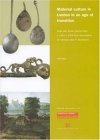
A survey of some of the different tools used to measure weight, including pan balances and steelyard balances, concentrating on real-world examples (rather than religious or allegorical examples, like St. Michael or Justice).
PAN BALANCES
- Replica of an ancient Roman equal-arm balance
- Roman balance and weights, 350
- Roman coins reused as weights in a 6th century Anglo-Saxon balance
- Celtic bronze balance beam and lead weight, Isle of Man, 8th century
- Late Anglo-Saxon folding balances found in South Gloucestershire, Icklingham, and Exeter
- Late Saxon Balances and Weights from England
- Reproduction of a foldable balance based on a London find
- 14th century folding balance found in Wacton
- Le Jeu des échecs moralisé (University of Chicago Library 392, image 53), c. 1365
- Tacuinum Sanitatis (BNF Nouvelle acquisition latine 1673), c. 1390-1400: merchants selling butter (fol. 58), salted meat (fol. 66), sugar (fol. 81), and sugar candy (fol. 81v)
- Weights and measures, and sounds, De proprietatibus rerum (BNF Fr. 216, fol. 338), 14th-15th century
- Tacuinum Sanitatis (BNF Latin 9333), 15th century: merchants selling rice (fol. 44), cheese (fol. 58v), salted fish (fol. 80v), sugar (fol. 89), and camphor (fol. 91)
- Libra, a missal (ÖNB 1850, fol. 5r), c. 1411-1419
- Examples in the Mendel Hausbuch include: Cuntz in der Wag (c. 1425), Perchtolt Kromer genannt vslaub (1453), Jorg Nueßmesßer (1495), Haintz Mayr (1528), Jorg Weinprenner (1533)
- Bakers, The Hours of Catherine of Cleves (PML M.917, fol. 226), c. 1440
- St. Eligius in his Workshop by Petrus Christus, 1449
- An apothecary, De proprietatibus rerum (BNF Fr. 218, fol. 111), fourth quarter of the 15th century
- A shopkeeper (fol. 76v), a money-changer (fol. 131r), and another money-changer (fol. 154v), Schachzabelbuch (ÖNB 3049), 1479
- Cy speaks about the state of merchants and commerce (cloth merchants showing honesty in weights and measurements), Le Livre de bonnes moeurs de Jacques Legrand (Musée Condée 297, fol. 122v), c. 1490
- A silver-gilt balance for weighing gold, along with its box (painted with the heraldry of Harsdorf and Nützel), made in Nuremburg in 1497
- Weighing olives, Hortus Sanitatis, 1497
- Cord pivot, balance and set of weights, ivory, Persian, 16th century
- Two models of self-indicating balances designed by Da Vinci
- The Moneylender and his Wife (see detail) by Quentin Massys, 1514
- Melencolia I by Albrecht Dürer, 1514
- Scales and weights, The Tudor Pattern Book (Ashmole 1504, fol. 12v), c. 1520-1530
- Portrait of Georg Gisze (detail) by Hans Holbein the Younger, 1532
- The Banker and His Wife by Marinus von Reymerswale
- The Moneychanger and His Wife by Marinus von Reymerswale, 1539
- Woman Weighing Gold by Jan Sanders von Hemessen
- A balance, 16th century
- Marxs Leutner, Landauer Hausbuch (Amb. 279.2, fol. 39r), 1551
- Enamelling work, Schwazer Bergbuch (TLF Cod. Dipl. 856, fol. 162r), 1556
- Enamelling work, Schwazer Bergbuch (ÖNB 10852, fol. 159v), 1561
- The Scale-Maker, Das Ständebuch, 1568
- A pan-balance for weighing fish, from Wasserburg, 1583
- Portrait of a woman holding a balance by Thomas de Keyser, c. 1625
STEELYARD BALANCES
- Roman bronze steelyard, c. 43-410
- Ancient Roman steelyard from Pompeii, 79 AD
- Bronze steelyard (statera) with lead weights, Roman Britain, 1st-2nd century
- Roman steelyard and weight from Caernarfon
- Portable steelyard balance found in Worcestershire, 1st-4th century
- Steelyard from the Mästermyr find
- Late Saxon Balances and Weights from England
- Satire of the merchant's greed by Pieter Brueghel the Elder, c. 1550-1560
- Butcher's Shop by Annibale Carracci, 1580s
- Balance made in Franconia in 1601
- A 17th century steelyard
TUMBRELS
- The medieval tumbrel, found in England and dating from c. 1279-1344
- A tumbrel found at Anglesey, c. 1351-1412
WEIGHTS
More weights can be found through the UK Detector Finds Database and the Portable Antiquities Scheme's Finds Database.
- Bronze steelyard weight with a bust of a philosopher, Roman Britain, 1st-2nd century
- Steelyard weight with a bust of a boxer, Roman Britain, 1st-4th century
- Steelyard weights with busts of frenzied maenads, Roman Britain, 1st-4th century
- Steelyard weight with a bust of a Byzantine princess, 400-450
- Viking polyhedral bullion weight, c. 850-950
- Late Saxon Balances and Weights from England
- Early medieval lead weights from Llanbedr-goch, 10th century
- Glass weight made in Fatimid dynasty Egypt, probably used to balance gold coinage weighing a quarter of a dinar, 1160-1171 (for additional glass coin weights, see 360:2-1900, 360:8-1900, 360:10-1900, 360:12-1900, or 360:22-1900)
- Steelyard weight found at Mongomery Castle, second half of the 13th century; and another steelyard weight from the 13th century, also found in England. Both feature the heraldry of Richard, Earl of Cornwall, and are linked with the Hanseatic League.
- A weight (probably for a steelyard balance) made in Nuremburg in the first half of the 15th century; also here (shown with a 17th century weight)
- An iron weight with a comical engraving and the date 1558
- Watermill, New discoveries; the sciences, inventions, and discoveries of the Middle Ages and the Renaissance as represented in 24 engravings issued in the early 1580’s by Stradanus
- Set of Exchequer standard Avoirdupois bronze weights, 1582-1588 (also here)
